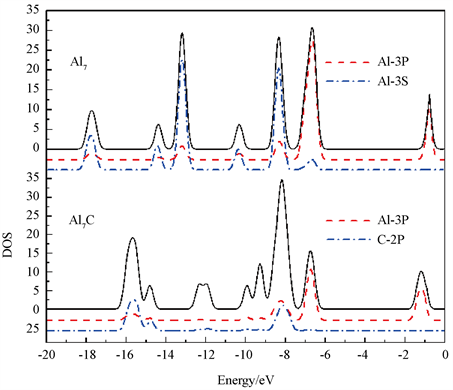Advances in Condensed Matter Physics
Vol.
09
No.
02
(
2020
), Article ID:
35508
,
6
pages
10.12677/CMP.2020.92004
The Analysis of Electronic Structure of Al7C Cluster
Huihui Yang*, Yuxin Chen
School of Science, Xi’an Aeronautical University, Xi’an Shannxi

Received: Apr. 22nd, 2020; accepted: May 5th, 2020; published: May 12th, 2020

ABSTRACT
Doping carbon into aluminum cluster can significantly increase the stability and changes the electronic structure of the aluminum cluster. Analyses of the molecular orbitals show that the C 2P and Al 3S orbitals overlap very well. The molecular orbitals of Al7C accord with the shell structures predicted by the jellium model. The electronic configuration of Al7C is 1S21P62S21D101F5.
Keywords:Al7C Cluster, Density of States, Molecular Orbital

Al7C团簇的电子结构分析
杨慧慧*,陈雨欣
西安航空学院,理学院,陕西 西安

收稿日期:2020年4月22日;录用日期:2020年5月5日;发布日期:2020年5月12日

摘 要
碳掺杂铝团簇可以明显增强团簇的稳定性,改变铝团簇的电子结构。分子轨道分析结果表明C的2P轨道和Al的3S轨道形成了很好的重叠。Al7C团簇的分子轨道与凝胶模型预测的一致。Al7C团簇的电子组态是1S21P62S21D101F5。
关键词 :Al7C团簇,态密度,分子轨道

Copyright © 2020 by author(s) and Hans Publishers Inc.
This work is licensed under the Creative Commons Attribution International License (CC BY 4.0).
http://creativecommons.org/licenses/by/4.0/


1. 引言
原子与分子物理是在原子分子尺度上研究物质的微观结构与性质,以及物质之间相互作用规律的物理学分支,是认识宏观物质结构与性质的基础。原子团簇构成了连接宏观物质与微观的原子分子之间的桥梁,对于推动基础科学研究和新技术应用开发起到了十分重要的作用。小团簇撞出大时代,团簇研究在化学、环境与材料科学、生命科学、新能源乃至航天、先进制造等高技术领域都占据着重要的地位,也出现了许多新的研究课题,如超冷原子、高离化态、超原子团簇等,使团簇物理成为当前国际上相当活跃的物理学分支之一。
团簇研究主要涉及的是团簇的稳定结构,团簇的组装与凝聚,团簇的合成与检测,团簇的电离、相变、光吸收、发光、电学、磁学性质等。其中团簇的结构是团簇研究的基础。铝作为地壳中含量最丰富的金属,具有轻质、非磁性、延展性好的特点,在交通运输、航空航天、机械制造等诸多领域有着广泛的应用。因此,关于Al团簇的研究一直是人们关注的热点。铝的电子组态是[Ne]3S2P1,3S和3P轨道之间的能级差非常大,约4.0 eV,因此Al团簇具有许多和单价碱金属类似的性质 [1] [2]。凝胶模型在碱金属团簇的研究中有着广泛的应用并取得了成功,已有大量报道指出铝团簇的稳定性和电子结构满足球状凝胶模型,包含20和40个价电子的Al+ 7和Al− 13团簇具有特殊的稳定性,但三价铝形成的团簇比碱金属团簇更复杂 [3] - [9]。用适用于一价碱金属团簇的凝胶模型描述铝团簇时,存在两个重要问题:一是由于对于小尺寸的铝团簇,S和P的重叠非常小,可表现出单价电子的行为,但是随着团簇尺寸增大,S和P轨道逐渐展宽最终会发生重叠;二是铝团簇离子芯对球状凝胶模型的势函数有较大的扰动,因此,某些尺寸的团簇可能和凝胶模型之间存在偏差 [8]。Al团簇中掺杂不同的原子可明显改变团簇的稳定性和电子结构。掺杂原子可分为碱金属碱土金属掺杂(如Li、Na、Mg等) [10] [11] [12] [13]、过渡金属掺杂(如Fe、Ti、Mn、Cu等) [14] [15] [16] 和非金属掺杂(如C、Si、N等) [17] [18] [19]。我们之前也一直在关注非金属C原子掺杂Al团簇的研究,并取得了一定的进展。之前的研究表明Al− 7团簇可解离氢分子,解离能垒为0.75 eV,C掺杂可明显增强铝团簇的稳定性,且C掺杂的Al6C团簇可有效解离氢分子,能垒仅0.30 eV [17] [20] [21]。本文详细分析了Al7C团簇的态密度和分子轨道,并将其与纯的Al7团簇进行了详细的比较。
2. Al7和Al7C团簇的几何结构
团簇的初始结构来自文献 [21] 和 [22]。图1给出了Al7和Al7C团簇的稳定结构。Al7团簇中其中6个Al构成一个倾斜的三棱柱,剩余的一个Al原子覆盖在三棱柱的一个侧面。C原子掺杂Al7团簇后,位于三棱柱的中间,使Al7团簇的稳定性增强。
3. Al7和Al7C团簇的态密度
Al7和Al7C团簇的总态密度(DOS)和分态密度(PDOS)在图2中给出。态密度图采用Multiwfn软件完成。Al7团簇具有21个价电子,构成开壳层结构,形成了21个自旋轨道。在−6.62 eV附近的第一个占据轨道的峰包括七个能级,从分态密度可看出它们主要由铝的3P轨道组成。其余14个态(能级从−8.15 ev~−17.67 ev)主要由铝的3S轨道形成,见图2。
Al7C有25个价电子,占据25个自旋轨道。主要由碳的2S轨道组成的能级位于价带的底部,能级约为−24.5 eV,在图2中没有显示。占据轨道的第一个峰包括−6.61 eV、−6.75 eV和−6.87 eV的三个能级,分态密度表明这些态是由Al 3P轨道形成的。−8.2 eV附近的峰包括9个能级,−15.8 eV附近的峰包括5个能级。从态密度可看出这些态主要由Al的3S和C的2P轨道组成,见图2。对分子轨道的进一步分析表明,C的2P和Al的3S轨道重叠得很好。

Figure 1. The stable structures of Al7 and Al7C clusters
图1. Al7和Al7C团簇的稳定结构

Figure 2. The density of states of Al7 and Al7C clusters
图2. Al7和Al7C团簇的态密度
4. Al7和Al7C团簇的分子轨道
Al7团簇具有21个价电子,占据21个自选轨道,有11个α轨道和10个β轨道,图3给出了11个α轨道的分子轨道图,其中α-46是最高占据轨道(HOMO)。从图3可看出α-36的分子轨道是1S轨道,α-37、38、39是三个1P轨道,接下来的α-40、41、42、43、44对应于5个1d轨道,α-45对应1F轨道,HOMO轨道α-46对应2S轨道。α轨道上的价电子组态是:1S11P31D51F12S1,这与凝胶模型的电子组态1S21P62S21D101F14存在差异,2S能级升高,位于1F之上。
Al7C团簇具有25个价电子,占据25个自选轨道,有13个α轨道和12个β轨道,图4给出了13个α轨道的分子轨道图。α-37是1S轨道,α-38、39、40是三个1P轨道,α-41对应2S轨道。接下来的5个分子轨道对应1D轨道,α-47、48、49对应1F轨道。α轨道上的价电子组态是:1S11P32S11D51F3,β轨道上的价电子组态是:1S11P32S11D51F2,总的价电子组态是:1S21P62S21D101F5,凝胶模型给出34个价电子的组态是1S21P62S21D101F14,可看出Al7C中价电子的组态与凝胶模型给出的一致。C的掺杂明显改变了纯的Al团簇的电子结构,Al-C团簇体系可用凝胶模型描述。

Figure 3. The 11 α molecular orbitals of Al7 cluster
图3. Al7团簇的11个α轨道的分子轨道图

Figure 4. The 13 α molecular orbitals of Al7C cluster
图4. Al7C团簇的13个α轨道的分子轨道图
5. 小结
本文分析比较了Al7C团簇与纯的Al7团簇的态密度和分子轨道。态密度分析表明Al7C团簇的能级较高的部分主要由Al的3P轨道形成,价电子的带底是由C的2S组成的,中间的能级由Al的3S和C的2P轨道组成。分子轨道分析表明Al7团簇中2S能级升高,位于1F之上。Al7C团簇的价电子组态为:1S21P62S21D101F5,与凝胶模型一致。
基金项目
大学生创新创业训练项目(S201911736023, DCX2019043),西安航空学院校级科研项目(2018KY0207)。
文章引用
杨慧慧,陈雨欣. Al7C团簇的电子结构分析
The Analysis of Electronic Structure of Al7C Cluster[J]. 凝聚态物理学进展, 2020, 09(02): 26-31. https://doi.org/10.12677/CMP.2020.92004
参考文献
- 1. Rao, B.K. and Jena, P. (2001) Energetics and Electronic Structure of Carbon Doped Aluminum Clusters. The Journal of Chemical Physics, 115, 778. https://doi.org/10.1063/1.1379973
- 2. Kawamata, H., Negishi, Y., Nakajima, A. and Kaya, K. (2001) Electronic Properties of Substituted Aluminum Clusters by Boron and Carbon Atoms (AlnBm−/AlnCm−); New Insights into s-p Hybridization and Perturbed Shell Structures. Chemical Physics Letters, 337, 255-262. https://doi.org/10.1016/S0009-2614(01)00198-1
- 3. Schriver, K.E., Persson, J.L., Honea, E.C. and Whetten, R.L. (1990) Electronic Shell Structure of Group-IIIA Metal Atomic Clusters. Physical Review Letters, 64, 2539. https://doi.org/10.1103/PhysRevLett.64.2539
- 4. Clemenger, K. (1985) Ellipsoidal Shell Structure in Free-Electron Metal Clusters. Physical Review B, 32, 1359. https://doi.org/10.1103/PhysRevB.32.1359
- 5. Brack, M. (1993) The Physics of Simple Metal Clusters: Self-Consistent Jellium Model and Semiclassical Approaches. Reviews of Modern Physics, 65, 677. https://doi.org/10.1103/RevModPhys.65.677
- 6. de Heer, W.A. (1993) The Physics of Simple Metal Clusters: Experimental Aspects and Simple Models. Reviews of Modern Physics, 65, 611. https://doi.org/10.1103/RevModPhys.65.611
- 7. Cheng, H.P., Berry, R.S. and Whatten, R.L. (1991) Electronic Structure and Binding Energies of Aluminum Clusters. Physical Review B, 43, 10647-10653. https://doi.org/10.1103/PhysRevB.43.10647
- 8. Li, X., Wu, H., Wang, X.B. and Wang, L.S. (1998) s-p Hybridization and Electron Shell Structures in Aluminum Clusters: A Photoelectron Spectroscopy Study. Physical Review Letters, 81, 1909. https://doi.org/10.1103/PhysRevLett.81.1909
- 9. Ma, L., Issendorff, B. and Aguado, A. (2010) Photoelectron Spectroscopy of Cold Aluminum Cluster Anions: Comparison with Density Functional Theory Results. The Journal of Chemical Physics, 132, Article ID: 104303. https://doi.org/10.1063/1.3352445
- 10. Wang, H., Zhang, X., Ko, Y.J., Grubisic, A., Ganteför, G., Schnöckel, H., Eichhorn, B.W., Lee, M.S., Jena, P., Kandalam, A.K., Kiran, B. and Bowen, K.H. (2014) Aluminum Zintl Anion Moieties within Sodium Aluminum Clusters. The Journal of Chemical Physics, 140, Article ID: 054301. https://doi.org/10.1063/1.4862989
- 11. Khanna, S.N., Rao, B.K. and Jena, P. (2002) Electronic Signature of the Magicity and Ionic Bonding in Al13X (X = Li-K) Clusters. Physical Review B, 65, Article ID: 125105. https://doi.org/10.1103/PhysRevB.65.125105
- 12. Luo, Z., Grover, C.J., Reber, A.C., Khanna, S.N. and Castleman Jr., A.W. (2013) Probing the Magic Numbers of Aluminum-Magnesium Cluster Anions and Their Reactivity toward Oxygen. Journal of the American Chemical Society, 135, 4307-4313. https://doi.org/10.1021/ja310467n
- 13. Osorio, E., Vasquez, A., Florez, E., Mondragon, F., Donald, K.J. and Tiznado, W. (2013) Theoretical Design of Stable Small Aluminium-Magnesium Binary Clusters. Physical Chemistry Chemical Physics, 15, 2222-2229. https://doi.org/10.1039/C2CP42015E
- 14. Rexer, E.F., Jellinek, J., Krissinel, E.B., Parks, E.K. and Riley, S.J. (2002) Theoretical and Experimental Studies of the Structures of 12-, 13-, and 14-Atom Bimetallic Nickel/Aluminum Clusters. The Journal of Chemical Physics, 117, 82. https://doi.org/10.1063/1.1481386
- 15. Reddy, B.V., Khanna, S.N. and Deevi, S.C. (2001) Electronic Structure and Magnetism in (FeAl)n (n ≤ 6) Clusters. Chemical Physics Letters, 333, 465-470. https://doi.org/10.1016/S0009-2614(00)01393-2
- 16. Bailey, M.S., Wilson, N.T., Roberts, C. and Johnston, R.L. (2003) Structures, Stabilities and Ordering in Ni-Al Nanoalloy Clusters. The European Physical Journal D, 25, 41-55. https://doi.org/10.1140/epjd/e2003-00218-2
- 17. Yang, H., Zhang, Y. and Chen, H. (2014) Dissociation of H2 on Carbon Doped Aluminum Cluster Al6C. The Journal of Chemical Physics, 141, Article ID: 064302. https://doi.org/10.1063/1.4891860
- 18. Du, N., Yang, H. and Chen, H. (2017) Covalent versus Ionic Bonding in Al-C Clusters. The Journal of Physical Chemistry A, 121, 4009-4018. https://doi.org/10.1021/acs.jpca.7b01532
- 19. Naumkin, F.Y. (2008) Flat-Structural Motives in Small Alumino-Carbon Clusters CnAlm (n = 2-3, m = 2-8). The Journal of Physical Chemistry A, 112, 4660-4668. https://doi.org/10.1021/jp711230x
- 20. 李文杰, 杨慧慧, 陈宏善. H2在Al7-团簇解离吸附的理论研究[J]. 物理学报, 2013, 62(5): 053601.
- 21. 杨慧慧, 李文杰, 陈宏善. 碳掺杂铝团簇AlnC (n = 6、7)的电子结构与稳定性[J]. 原子与分子物理学报, 2013, 30(4): 579-584.
- 22. Rao, B.K. and Jena, P. (1999) Evolution of the Electronic Structure and Properties of Neutral and Charged Aluminum Clusters: A Comprehensive Analysis. The Journal of Chemical Physics, 111, 1890. https://doi.org/10.1063/1.479458
NOTES
*通讯作者。